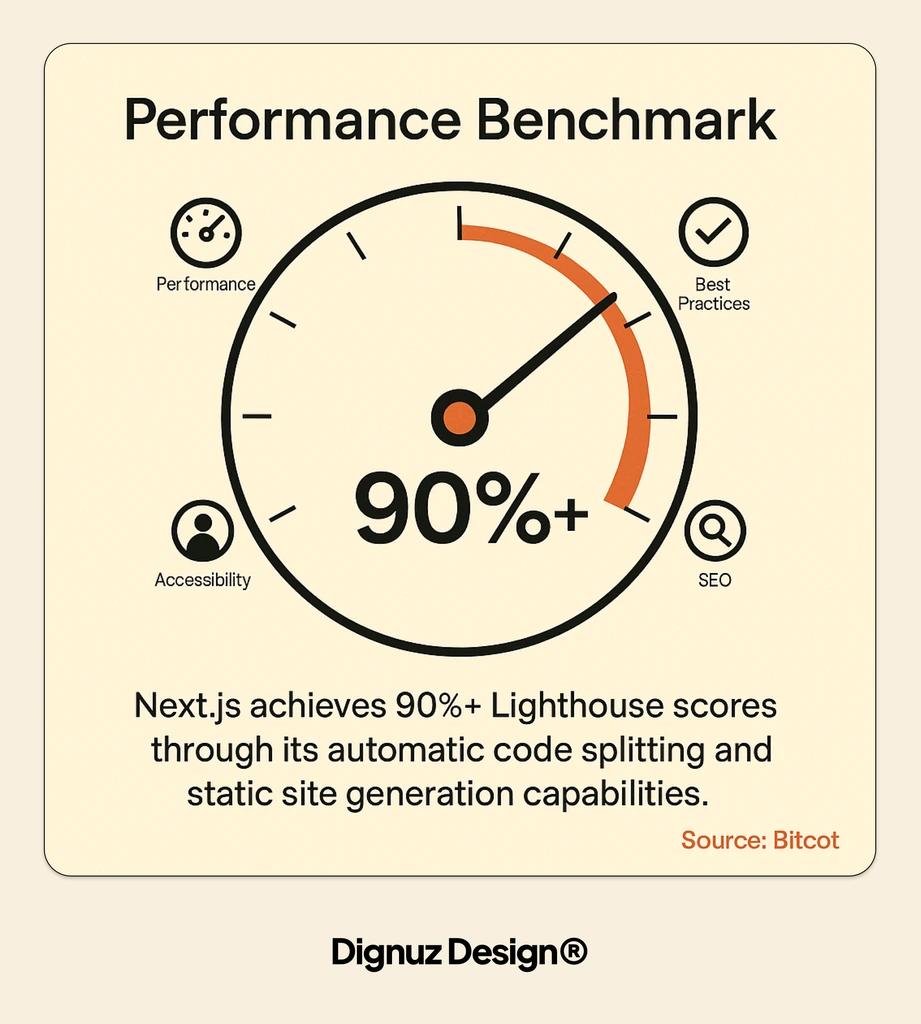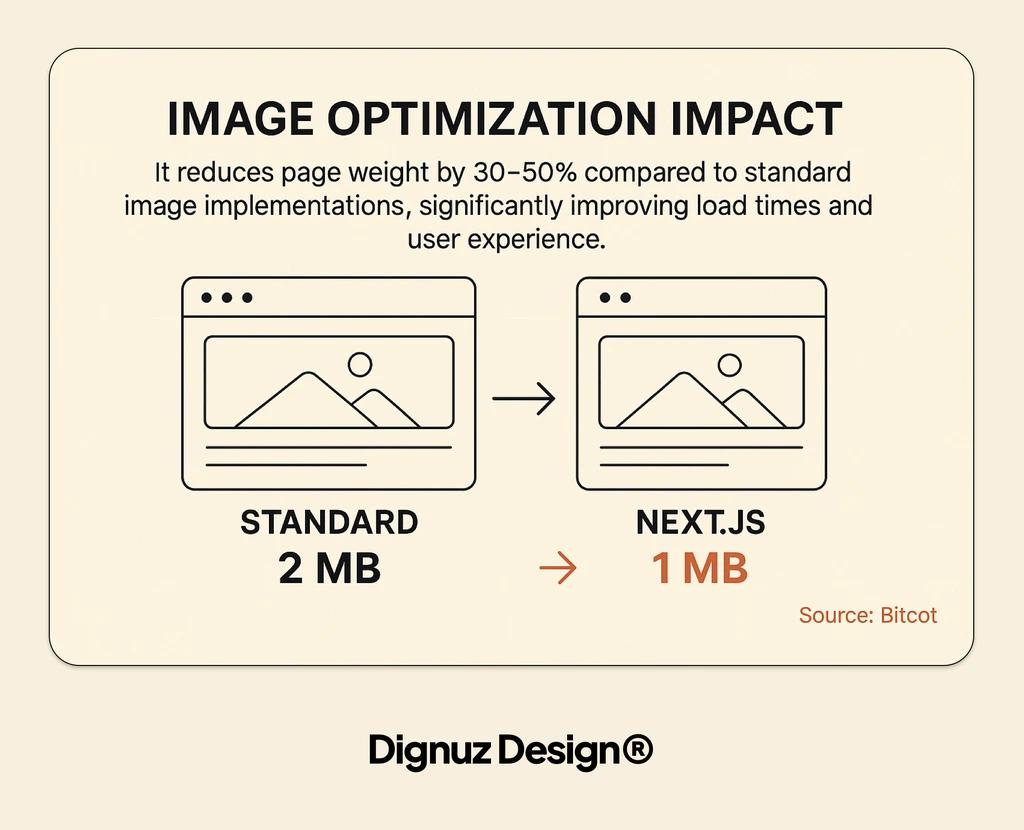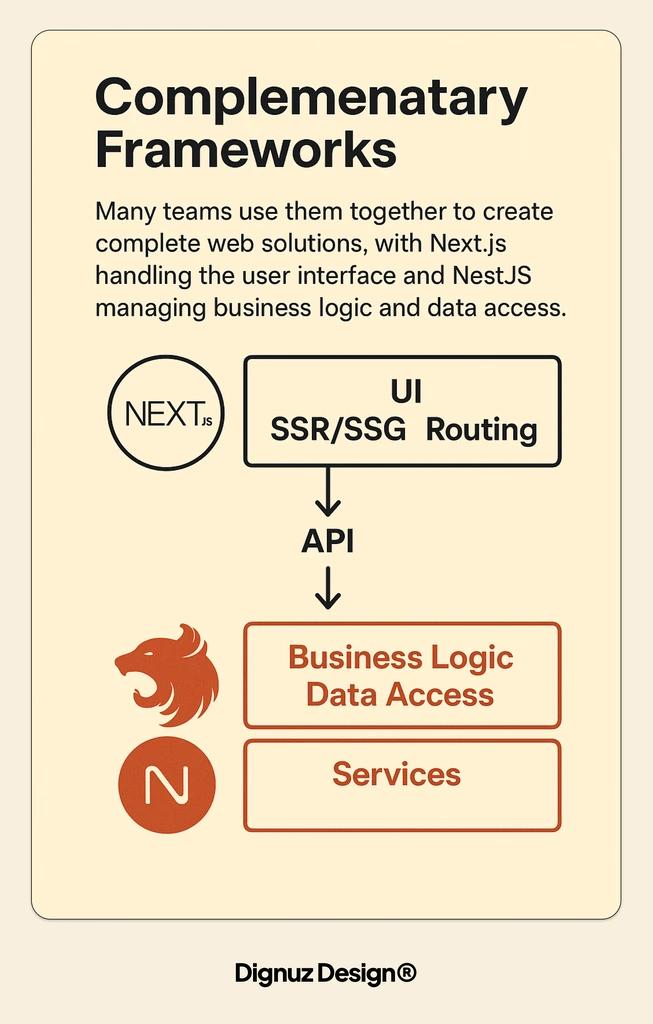Next.js vs NestJS

Key Differences and Which Framework is Right for Your Project
Selecting the right framework forms the foundation of successful web development projects. Modern JavaScript development offers numerous options, with Next.js and NestJS standing out as popular choices. Though their names sound similar, these frameworks serve entirely different purposes.
As specialists in custom website design, we understand how critical it is to choose the right technologies for your project. The wrong selection can lead to development challenges, performance issues, and maintenance headaches down the road.
This comparison guide examines both frameworks in detail. We'll explore their core purposes, performance characteristics, and ideal use cases. By the end, you'll have a clear understanding of which framework best suits your specific project requirements.

Understanding Next.js
Next.js is primarily a frontend framework built on top of React. It enhances React's capabilities by adding server-side rendering (SSR) and static site generation (SSG). These features address common challenges in React development like SEO optimization and initial load performance. (Source: Dev.to)
Created by Vercel, Next.js aims to provide a complete solution for React-based web applications. The framework simplifies many complex aspects of modern web development while maintaining flexibility for developers.
Key Features of Next.js
- Server-Side Rendering (SSR) - Generates HTML on the server for improved SEO and initial load speed
- Static Site Generation (SSG) - Pre-renders pages at build time for maximum performance
- Automatic Code Splitting - Loads only the JavaScript needed for each page
- Built-in Routing - File-system based router built on the concept of pages
- API Routes - Create API endpoints as Node.js serverless functions
Next.js achieves 90%+ Lighthouse scores through its automatic code splitting and static site generation capabilities. This exceptional performance makes it ideal for user-facing applications where speed matters. (Source: Bitcot)
The framework's built-in image optimization is another standout feature. It reduces page weight by 30-50% compared to standard image implementations, significantly improving load times and user experience. (Source: Bitcot)
Next.js integrates seamlessly with the Vercel platform, creating an optimized deployment environment. This tight integration simplifies the development-to-production workflow for teams of all sizes. (Source: Aalpha)
Understanding NestJS
NestJS serves an entirely different purpose in the development ecosystem. It's a backend framework for building server-side applications with Node.js. The framework draws heavy inspiration from Angular's architecture, bringing structure and organization to Node.js development. (Source: Aalpha)
Built with TypeScript at its core, NestJS encourages strongly-typed code and object-oriented programming principles. This structured approach helps teams build scalable, maintainable backend services.
Key Features of NestJS
- TypeScript Support - First-class TypeScript integration for type safety
- Modular Architecture - Angular-inspired modules for code organization
- Dependency Injection - Built-in DI system for better testability
- Middleware Support - Express-compatible middleware
- Microservices Ready - First-class support for microservice architecture
NestJS handles over 15,000 requests per second in benchmark tests, demonstrating its impressive performance capabilities for backend services. Its architecture supports linear scalability when deployed with container orchestration tools like Kubernetes. (Source: Dev.to)
The framework integrates with 80+ Nest-specific modules that extend its functionality for various use cases including database access, authentication, caching, and more. This rich ecosystem helps developers solve common backend challenges efficiently. (Source: Medium)
NestJS works well with message brokers like Kafka and RabbitMQ, making it suitable for event-driven architectures. This compatibility allows for building scalable, loosely-coupled systems.

Key Differences Between Next.js and NestJS
Before diving into the detailed comparison, let's clarify the fundamental difference between these frameworks. Next.js and NestJS target different parts of the application stack. Understanding this core distinction helps prevent confusion when evaluating them.
Primary Purpose:
- Next.js: Frontend framework for React applications
- NestJS: Backend framework for Node.js applications
Core Focus:
- Next.js: User interfaces with enhanced rendering
- NestJS: Server-side business logic and APIs
Rendering Capability:
- Next.js: Server-side and static rendering
- NestJS: API responses and data processing
Typical Position:
- Next.js: Client-facing application layer
- NestJS: Server-side application layer
Now let's examine more specific differences between these frameworks across several important dimensions.
Performance Characteristics
Both frameworks offer strong performance but optimize for different aspects of application development. This table highlights their performance strengths in their respective domains.
Optimization Focus
- Next.js: Page load speed and SEO
- NestJS: Request handling and throughput
Key Metrics
- Next.js: 90%+ Lighthouse scores, 30-50% reduced page weight
- NestJS: 15k+ requests/sec, linear scalability
Caching Capabilities
- Next.js: Built-in page and data caching
- NestJS: Configurable with external caching services
Scaling Model
- Next.js: Edge network distribution
- NestJS: Horizontal pod scaling
Ecosystem and Integration
The ecosystem surrounding each framework reflects their different purposes and target users. Let's compare what each offers in terms of libraries, tools, and integration capabilities.
Library Support:
- Next.js: 1500+ React libraries
- NestJS: 80+ Nest-specific modules
Primary Language:
- Next.js: JavaScript with optional TypeScript
- NestJS: TypeScript as first-class citizen
Platform Integration:
- Next.js: Seamless Vercel deployment
- NestJS: Works with any Node.js hosting
Third-party Services:
- Next.js: Content Management Systems, Analytics
- NestJS: Databases, Message Brokers, Caching
Developer Experience
The developer experience differs significantly between these frameworks. This comparison helps you understand what to expect when working with each technology.
Learning Curve:
- Next.js: Moderate (requires React knowledge)
- NestJS: Steeper (requires TypeScript and Angular-like patterns)
Community Size:
- Next.js: 180k+ GitHub stars, 4M+ weekly downloads
- NestJS: 65k+ GitHub stars, 1.2M+ weekly downloads
Documentation Quality:
- Next.js: Excellent with many examples
- NestJS: Comprehensive with detailed API docs
Development Speed:
- Next.js: Fast with hot reloading
- NestJS: Structured with powerful CLI tools
When evaluating these frameworks, it's important to consider both the immediate learning curve and the long-term maintenance benefits. While NestJS might take longer to learn initially, its structured approach often leads to more maintainable codebases as projects grow in complexity. (Source: Brilworks)

When to Choose Next.js
Next.js excels in specific scenarios where its capabilities directly address project requirements. Understanding these use cases helps you determine if it's the right choice for your project.
Consider Next.js for your project when:
Content-focused Websites
Next.js shines for content-heavy websites that need excellent SEO. Its server-side rendering generates HTML that search engines can easily index. This makes it perfect for marketing websites, blogs, and content portals.
The framework's built-in caching reduces server load by approximately 40% compared to client-side rendered applications. This efficiency translates to better performance and lower hosting costs. (Source: Bitcot)
E-commerce Applications
For online stores, Next.js offers the perfect balance of dynamic functionality and fast page loads. The improved performance directly impacts conversion rates and user satisfaction.
The image optimization feature is particularly valuable for product catalogs. Better image loading creates a smoother shopping experience while maintaining visual quality.
Interactive Web Applications
Next.js works well for applications that need both interactivity and good SEO. The hybrid rendering approach lets you choose the right strategy for each page in your application.
For real estate websites that need to showcase properties effectively, Next.js can provide the performance needed for what makes a real estate website stand out from competitors.
When to Choose NestJS
NestJS addresses different challenges than Next.js. Its strengths lie in creating robust backend services with clear architecture and strong typing.
Consider NestJS for your project when:
API Development
NestJS excels at building RESTful APIs and GraphQL services. Its structured approach helps maintain consistency across endpoints, which becomes increasingly important as your API grows.
The built-in validation, serialization, and error handling features accelerate API development. These utilities help teams deliver reliable APIs with less boilerplate code.
Microservices Architecture
The framework provides first-class support for microservices. NestJS applications can communicate using various transport mechanisms including TCP, Redis, MQTT, and more.
This flexibility allows teams to build loosely-coupled services that can scale independently. Each service can be developed, deployed, and maintained separately.
Enterprise Applications
For large-scale applications with complex business logic, NestJS offers the structure needed to keep code organized and maintainable. The module system helps divide functionality into cohesive units.
The dependency injection system promotes testability and loose coupling between components. This design makes it easier to write unit tests and mock dependencies.

Using Next.js and NestJS Together
While Next.js and NestJS serve different purposes, they complement each other perfectly in full-stack applications. Many teams use them together to create complete web solutions.
According to a 2025 survey, 68% of developers pair Next.js frontends with NestJS backends in their projects. This combination leverages the strengths of each framework in its respective domain. (Source: Aalpha)
Architecture for Combined Usage
When using both frameworks together, a typical architecture looks like this:
Frontend:
- Framework: Next.js
- Responsibility: User interface, SSR/SSG, routing, frontend state
Backend API:
- Framework: NestJS
- Responsibility: Business logic, data access, authentication, authorization
Data Layer:
- Framework: NestJS with ORMs/ODMs
- Responsibility: Database interactions, data validation, transactions
Services:
- Framework: NestJS Microservices
- Responsibility: Specialized functionality, third-party integrations
This separation of concerns creates a clean architecture that's easier to maintain. Each part of the application focuses on what it does best.
Implementation Considerations
When implementing a full-stack application with Next.js and NestJS, consider these best practices:
API Contract Definition - Define clear interfaces between frontend and backend
Type Sharing - Share TypeScript types/interfaces between projects
Authentication Strategy - Implement consistent auth across both layers
Development Environment - Set up a local environment that runs both simultaneously
Deployment Pipeline - Create a CI/CD process that handles both applications
This approach works particularly well for projects that need both powerful frontend experiences and robust backend services. Real estate platforms that integrate with optimizing Webflow sites for Google might benefit from this dual-framework approach.
Conclusion
Next.js and NestJS serve different purposes in the JavaScript ecosystem. Next.js excels as a frontend framework for React applications, providing enhanced rendering capabilities that improve performance and SEO. NestJS shines as a backend framework, offering structure and scalability for server-side applications.
Your choice between these frameworks should depend entirely on your project requirements:
- Choose Next.js for content-focused websites, e-commerce platforms, and interactive applications that need good SEO
- Choose NestJS for APIs, microservices, and enterprise backend applications that need structure and scalability
- Consider using both together for full-stack applications where you need the strengths of each framework
Remember that the right framework depends on your specific needs. Consider factors like your team's expertise, project requirements, and long-term maintenance plans when making your decision.
For projects that need custom web development with either framework, our team specializes in creating tailored solutions that leverage the best technologies for each unique situation. Our experience with Webflow development gives us insight into how different technologies can work together to create exceptional digital experiences.
Whichever framework you choose, ensure it aligns with your project goals and team capabilities for the best chance of success.



